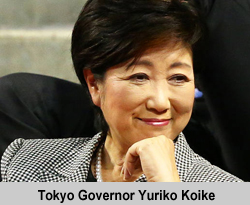
 |
Japanese local government and mayors of largest cities Japan 2025 Please visit our 2025 page of Japanese government and mayors Please visit our page of Japanese women mayors ON THIS PAGE: Japanese mayors ||| Japanese cities and regions ||| Japan's mayoral system ||| Mayors of largest Japanese cities ||| Japan's political parties ||| |
|||||||||||||||||||||||||||||||||||||||||||||||||||||||||||||||||||||||||||||||||||||||||
FRONT PAGE About us   ON OTHER PAGES JAPAN Local government in Japan WORLD MAYOR Mayors wanted for Stronger | Fairer | Greener cities COVID-19 CoronaVirus: How cities from around the world are affected MAYORS Mayors in Europe: Politics & Powers (2019) World's capital cities and their mayors (2020) Salaries of British mayors Salaries of French mayors Salaries of German mayors Salaries of Japanese mayors African American Mayors Belgian Mayors (2020) British Mayors (2021) Canadian Mayors (2021) French Mayors (2020) German mayors (2021) Indian mayors (2021) Italian mayors (2021) Japanese mayors (2021) Polish mayors (2020) Spanish mayors (2020) Turkish mayors (2019) American mayors (2021) Women in US local government World Mayors and politics Voter turnout - an international comparison |
 Japanese local government Japanese local governmentand mayors of largest cities By City Mayors Research November 2021: Japan, the world’s third-largest economy by GDP and 10th largest country by population, is a unitary state, governed at national level by a Prime Minister and Cabinet largely chosen from the bi-cameral National Diet. The two-tier local government system in Japan is composed of 47 prefectural governments (roughly akin to a county), each headed by a directly-elected Governor (elected on a four-year term) and 1,719 municipalities, each headed by a directly-elected Mayor (elected likewise). The nature and role of local government is codified in the Local Autonomy Law (LAL) issued under the post-war Constitution of Japan of 1947, which guarantees local autonomy against the national government, who retain a degree of control over localities through subsidies. Following years of debate, in 1995 a Decentralization Promotion Law (DPL), backed by a standing committee, was passed to make the roles between central and local governments clearer and promote enhanced autonomy, which was intended to promote localisation and prepare for an ageing society. This movement coincided with a voluntary municipal merger process with financial assistance from central government, with a statute aimed at enhancing the administrative capacities of municipalities, which has seen their number decrease from 3,232 as of March 1999 to 1,719 today. Japan’s cities and regions With the exception of the capital Tokyo and the island of Hokkaido, most prefectural governments are styled in Japanese as ‘ken’ (e.g. Hiroshima-ken, as opposed to Hiroshima-shi, the city government), with the two historically significant (as former capital etc.) prefectures of Kyoto and Osaka known as ‘fu’ (e.g. Osaka-fu, as opposed to Osaka-shi, the city government). Of the municipalities, there are several classes of city, with the most basic and numerous class of ‘city’ broadly enjoying the same powers and status as towns or villages (the designation stemming from its population size, basically more than 50,000 residents). All cities supply residents with water services, waste collection and disposal, public health, social welfare, parks, environmental services, planning/development control, economic development, fire and rescue, elementary schools and adult education colleges. 40 cities with populations of 200,000 or more were known as ‘Special Cities’ and entitled to provide some degree of prefectural services (such as care services, health, environmental services, urban planning, teacher training etc.) locally, with a further 41 cities of 300,000 or more residents known as ‘Core Cities’ which can provide further additional services. The ‘Special City’ designation was later abolished and merged into the class of ‘Core Cities’, with the population requirement then lowered to 200,000 for these. The 20 ‘Designated Cities’ each have populations above 700,000 (as well as density requirements and ‘regional’ status) and carry out most services within their jurisdiction rather than under the prefectural government. They are further required to subdivide themselves into ‘wards’ in order to carry out basic functions such as resident registration and tax collection on a more local level. All such designations must be approved by the Cabinet of Japan following an application by the relevant municipality and prefecture. Tokyo is today unique within Japan as a metropolis (‘to’) rather than prefecture or city level government, with Tokyo Metropolitan Government (headed by a Governor, rather than Mayor) sitting above 23 ‘Special Wards’ in the centre and a further 26 cities, five towns and eight villages in the periphery. Historically, the Designated Cities owe their origins to the creation of the first local authorities in 1898 in the then principal regional cities outside of Tokyo – Osaka, Kyoto, Nagoya and Kobe. A 1956 amendment to the LAL allowed these cities (as well as Yokohama) in Japan to receive this Designated City status for the first time, with further cities approved by the Cabinet over the decades up to the 20 as of 2013. The Core and Special City designations were created under the 1995 DPL process to recognise the growing importance of the second-tier cities by awarding them an intermediate degree of enhanced autonomy. Some larger Japanese cities, most notably Osaka and Nagoya, have recently expressed their desire to become ‘metropolises’ themselves through merging the prefectural and city tiers, with a national law passed in 2012 to enable this following agreement among the tiers backed by a local referendum. Japan’s mayoral system While Japanese mayors are directly elected for four-year terms with no term limits, most candidates prefer stand as independents and are then backed by local chapters of the main national parties. Foreign nationals cannot vote in Japanese municipal elections and all candidates must be 25 years or older (voters must be aged 18 or older). Mayors can be subject to recall through residents’ petition, provided basic thresholds are met. City mayors are also assisted in their duties by vice mayors, though any appointment must then be ratified by the city assembly, and in some cases mayors have requested vice mayors be seconded from central government to assist them in policy coordination. Japan’s designated city mayors are represented by the Designated City Mayors Association, founded in 2003. The association is one of several local government associations of Japan, which are represented outside of Japan in countries such as the US, UK and China by the Council of Local Authorities for International Relations (CLAIR), founded in 1988.. Mayors of Designated Cities of Japan and Governor of the Tokyo Metropolis
*Japan's political parties CDP – Constitutional Democratic Party (centre-left) JCP – Japanese Communist Party (left) JIP - Japan Innovation Party (right) KP – Komeito Party (centre-right, often stands jointly with LDP) LDP – Liberal Democratic Party (centre-right) SDP – Social Democratic Party (left) Follow @City_Mayors |